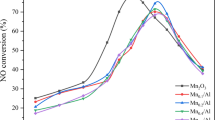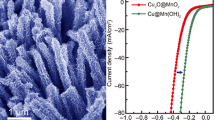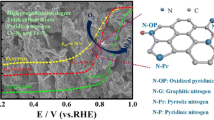Abstract
The development of oxygen evolution reaction (OER) catalysts with high activity, long-term stability, and cost-effectiveness is crucial in large-scale hydrogen production. In this study, we present a simple and efficient synthesis strategy for MnCoO catalysts using a two-step co-precipitation and annealing method. MnCoO-1 and MnCoO-2 were synthesized with different Mn:Co precursor ratios (1:3 and 2:2, respectively), resulting in enhanced electrocatalytic activity for OER in an alkaline electrolyte. MnCoO-1 exhibited hexagonal plate morphology, while MnCoO-2 showed cubic nanostructures with a small number of nano-plates. Compared to Co3O4 and MnCoO-2, MnCoO-1 demonstrates a significantly lower overpotential, achieving an OER current density of 75 mA cm−2 at 546.0 mV, indicating enhanced OER activity. Moreover, MnCoO-1 achieves an even higher OER current density of 100 mA cm−2 at an overpotential of 606 mV versus RHE, which is considerably lower than the overpotentials observed for Co3O4 (733.7 mV) and MnCoO-2 (776.0 mV) catalysts. This improvement can be attributed to the unique morphology and structure of MnCoO-1, where Mn ions were efficiently incorporated into the Co3O4 lattice without disrupting its crystal structure. Furthermore, MnCoO-1 demonstrated remarkable long-term electrochemical stability against OER in a 1.0 M KOH aqueous electrolyte, maintaining a high current density of 50 mA cm−2 in 24 h.
Graphical Abstract











Similar content being viewed by others
References
S. Bertrand, Environmental climate, environmental, and health impacts of fossil fuels fact sheet. Energy Study Inst. 2021, 1 (2021).
M. Momirlan and T.N. Veziroglu, The properties of hydrogen as fuel tomorrow in sustainable energy system for a cleaner planet. Int. J. Hydrogen Energy 30, 795 (2005).
U. Bossel and B. Eliasson, Energy and hydrogen economy. Eur. Fuel Cell Forum Lucerne 36, 1 (2002).
P.P. Edwards, V.L. Kuznetsov, W.I.F. David, and N.P. Brandon, Hydrogen and fuel cells: towards a sustainable energy future. Energy Policy 36, 4356 (2008).
K.T. Møller, T.R. Jensen, E. Akiba, and H. Li, Hydrogen–a sustainable energy carrier. Prog. Nat. Sci. Mater. Int. 27, 34 (2017).
S. Wang, A. Lu, and C.-J. Zhong, Hydrogen production from water electrolysis: role of catalysts. Nano Converg. 8, 4 (2021).
J.D. Holladay, J. Hu, D.L. King, and Y. Wang, An overview of hydrogen production technologies. Catal. Today 139, 244 (2009).
J. Song, C. Wei, Z.-F. Huang, C. Liu, L. Zeng, X. Wang, and Z.J. Xu, A review on fundamentals for designing oxygen evolution electrocatalysts. Chem. Soc. Rev. 49, 2196 (2020).
Z. Ma, Y. Zhang, S. Liu, W. Xu, L. Wu, Y.-C. Hsieh, P. Liu, Y. Zhu, K. Sasaki, J.N. Renner, K.E. Ayers, R.R. Adzic, and J.X. Wang, Reaction mechanism for oxygen evolution on RuO2, IrO2, and RuO2@IrO2 core-shell nanocatalysts. J. Electroanal. Chem. 819, 296 (2018).
A.H. Reksten, H. Thuv, F. Seland, and S. Sunde, The oxygen evolution reaction mechanism at IrxRu1−xO2 powders produced by hydrolysis synthesis. J. Electroanal. Chem. 819, 547 (2018).
C.C.L. McCrory, S. Jung, I.M. Ferrer, S.M. Chatman, J.C. Peters, and T.F. Jaramillo, Benchmarking hydrogen evolving reaction and oxygen evolving reaction electrocatalysts for solar water splitting devices. J. Am. Chem. Soc. 137, 4347 (2015).
N.T. Suen, S.F. Hung, Q. Quan, N. Zhang, Y.J. Xu, and H.M. Chen, Electrocatalysis for the oxygen evolution reaction: recent development and future perspectives. Chem. Soc. Rev. 46, 337 (2017).
X. Li, X. Hao, A. Abudula, and G. Guan, Nanostructured catalysts for electrochemical water splitting: current state and prospects. J. Mater. Chem. A 4, 11973 (2016).
J. Du, F. Li, and L. Sun, Metal–organic frameworks and their derivatives as electrocatalysts for the oxygen evolution reaction. Chem. Soc. Rev. 50, 2663 (2021).
E.K. Kim, H.T. Bui, N.K. Shrestha, C.Y. Shin, S.A. Patil, S. Khadtare, C. Bathula, Y.Y. Noh, and S.H. Han, An enhanced electrochemical energy conversion behavior of thermally treated thin film of 1-dimensional CoTe synthesized from aqueous solution at room temperature. Electrochim. Acta 260, 365 (2018).
Z. Cai, X. Bu, P. Wang, J.C. Ho, J. Yang, and X. Wang, Recent advances in layered double hydroxide electrocatalysts for the oxygen evolution reaction. J. Mater. Chem. A 7, 5069 (2019).
L. Zhang, Q. Fan, K. Li, S. Zhang, and X. Ma, First-row transition metal oxide oxygen evolution electrocatalysts: regulation strategies and mechanistic understandings. Sustain. Energy Fuels 4, 5417 (2020).
H. Zhong, C.A. Campos-Roldán, Y. Zhao, S. Zhang, Y. Feng, and N. Alonso-Vante, Recent advances of cobalt-based electrocatalysts for oxygen electrode reactions and hydrogen evolution reaction. Catalysts 8, 559 (2018).
C. Yuan, H.B. Wu, Y. Xie, and X.W. Lou, Mixed transition-metal oxides: design, synthesis, and energy-related applications. Angew. Chem. Int. Ed. 53, 1488 (2014).
H.J. Lee, S. Back, J.H. Lee, S.H. Choi, Y. Jung, and J.W. Choi, Mixed transition metal oxide with vacancy-induced lattice distortion for enhanced catalytic activity of oxygen evolution reaction. ACS Catal. 9, 7099 (2019).
G. Maduraiveeran, Nanoporous structured mixed transition metal oxides nanomaterials for electrochemical energy conversion technologies. Mater. Lett. 283, 128763 (2021).
H. Osgood, S.V. Devaguptapu, H. Xu, J. Cho, and G. Wu, Transition metal (Fe Co, Ni, and Mn) oxides for oxygen reduction and evolution bifunctional catalysts in alkaline media. Nano Today 11, 601 (2016).
M. Nozari-Asbemarz, M. Amiri, H. Imanzadeh, A. Bezaatpour, S. Nouhi, P. Hosseini, M. Wark, and D. Seifzadeh, Mixed metal oxides as efficient electrocatalysts for water oxidation. Int. J. Hydrogen Energy 47, 5250 (2022).
H.H. Pham, D.C. Linh, T.T.A. Ngo, V.T.K. Oanh, B.X. Khuyen, S.A. Patil, N.H.T. Tran, S. Park, H. Im, H.T. Bui, and N.K. Shrestha, 1-D arrays of porous Mn0.21Co2.79O4 nanoneedles with an enhanced electrocatalytic activity toward the oxygen evolution reaction. Dalt. Trans. 52, 12185 (2023).
S. Ma, L. Sun, L. Cong, X. Gao, C. Yao, X. Guo, L. Tai, P. Mei, Y. Zeng, H. Xie, and R. Wang, Multiporous MnCo2O4 microspheres as an efficient bifunctional catalyst for nonaqueous Li-O2 batteries. J. Phys. Chem. C 117, 25890 (2013).
C. Li, X. Han, F. Cheng, Y. Hu, C. Chen, and J. Chen, Phase and composition controllable synthesis of cobalt manganese spinel nanoparticles towards efficient oxygen electrocatalysis. Nat. Commun. 6, 7345 (2015).
M. Gliech, A. Bergmann, C. Spöri, and P. Strasser, Synthesis–structure correlations of manganese–cobalt mixed metal oxide nanoparticles. J. Energy Chem. 25, 278 (2016).
S. Kwon, H.E. Lee, D. Han, and J.H. Lee, Low-temperature fabrication of crystalline MnCoO spinel film on porous carbon paper for efficient oxygen evolution reaction. Chem. Commun. 57, 3595 (2021).
A.K. Lebechi, A.K. Ipadeola, K. Eid, A.M. Abdullah, and K.I. Ozoemena, Porous spinel-type transition metal oxide nanostructures as emergent electrocatalysts for oxygen reduction reactions. Nanoscale 14, 10717 (2022).
M.-S. Park, J. Kim, K.J. Kim, J.-W. Lee, J.H. Kim, and Y. Yamauchi, Porous nanoarchitectures of spinel-type transition metal oxides for electrochemical energy storage systems. Phys. Chem. Chem. Phys. 17, 30963 (2015).
S. Kwon and J.H. Lee, A cobalt hydroxide nanosheet-mediated synthesis of core–shell-type Mn0.005Co2.995O4 spinel nanocubes as efficient oxygen electrocatalysts. Dalt. Trans. 49, 1652 (2020).
S. Zawar, G. Ali, G.M. Mustafa, S.A. Patil, S.M. Ramay, and S. Atiq, Mn0.06Co2.94O4 nano-architectures anchored on reduced graphene oxide as highly efficient hybrid electrodes for supercapacitors. J. Energy Storage 50, 104298 (2022).
L. Fu, Z. Liu, Y. Liu, B. Han, P. Hu, L. Cao, and D. Zhu, Beaded cobalt oxide nanoparticles along carbon nanotubes: towards more highly integrated electronic devices. Adv. Mater. 17, 217 (2005).
F. Wu, X. Guo, G. Hao, Y. Hu, and W. Jiang, Self-supported hollow Co(OH)2/NiCo sulfide hybrid nanotube arrays as efficient electrocatalysts for overall water splitting. J. Solid State Electrochem. 23, 2627 (2019).
B. Sidhureddy, J.S. Dondapati, and A. Chen, Shape-controlled synthesis of Co3O4 for enhanced electrocatalysis of the oxygen evolution reaction. Chem. Commun. 55, 3626 (2019).
K. Zhang, G. Zhang, J. Qu, and H. Liu, Disordering the atomic structure of Co(II) oxide via B-doping: an efficient oxygen vacancy introduction approach for high oxygen evolution reaction electrocatalysts. Small 14, e1802760 (2018).
F. Dionigi, Z. Zeng, I. Sinev, T. Merzdorf, S. Deshpande, M.B. Lopez, S. Kunze, I. Zegkinoglou, H. Sarodnik, D. Fan, A. Bergmann, J. Drnec, J.F. de Araujo, M. Gliech, D. Teschner, J. Zhu, W.-X. Li, J. Greeley, B.R. Cuenya, and P. Strasser, In-situ structure and catalytic mechanism of NiFe and CoFe layered double hydroxides during oxygen evolution. Nat. Commun. 11, 2522 (2020).
S. Trasatti, Electrochemical theory: oxygen evolution, Encyclopedia of Electrochemical Power Sources. ed. J. Garche (Amsterdam: Elsevier, 2009), pp. 49–55.
Acknowledgments
This research is funded by the Institute of Materials Science, Vietnam Academy of Science and Technology, under Grant Number CS.12/21-22.
Funding
Viện Khoa học vật liệu, Viện Hàn lâm Khoa học và Công nghệ Việt Nam (CS.12/21-22).
Author information
Authors and Affiliations
Contributions
HTB: conceptualization, investigation, and writing—original draft; HHP and DCL: electrochemical measurement; NDL and TTAN: sample preparation, investigations, and characterizations; VTKO: sample SEM characterization; ATP and PTS: writing—review and editing; NHT and J-YK: XPS measurement, fitting, and writing.
Corresponding author
Ethics declarations
Conflict of interest
The authors declare that they have no known competing financial interests or personal relationships that could have appeared to influence the work reported in this paper.
Additional information
Publisher's Note
Springer Nature remains neutral with regard to jurisdictional claims in published maps and institutional affiliations.
Supplementary Information
Below is the link to the electronic supplementary material.
Rights and permissions
Springer Nature or its licensor (e.g. a society or other partner) holds exclusive rights to this article under a publishing agreement with the author(s) or other rightsholder(s); author self-archiving of the accepted manuscript version of this article is solely governed by the terms of such publishing agreement and applicable law.
About this article
Cite this article
Bui, H.T., Hanh, P.H., Lam, N.D. et al. Efficient Synthesis and Enhanced Electrochemical Performance of MnCoO Catalysts for Oxygen Evolution Reaction. J. Electron. Mater. 53, 53–64 (2024). https://doi.org/10.1007/s11664-023-10802-2
Received:
Accepted:
Published:
Issue Date:
DOI: https://doi.org/10.1007/s11664-023-10802-2




